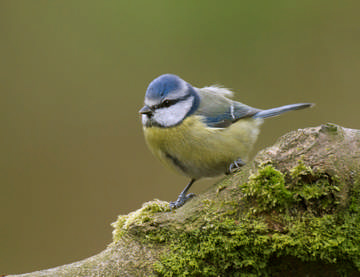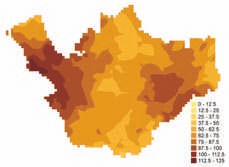
Blue Tit © Sue & Andy Tranter
The analysis of Breeding Bird Survey transects shows that this is our second most numerous species, with a breeding population of Cheshire and Wirral in 2004-05 of 195,250 birds (164,480-226,010). This massive total corresponds to an average of more than 150 pairs per tetrad, equivalent to a density of one pair per 2.6 ha across the entire county. This figure is 1.7% of the UK breeding population of 11.3 million birds (Newson et al 2008). National monitoring shows that Blue Tit populations have increased by about 14% in the last twenty years since our First Atlas, aided by mild winters, provision of food in gardens and the availability of nest boxes. The rise in population has been accompanied by decreasing clutch and brood sizes, and a substantial decline in the proportion of young birds in early autumn, in a clear demonstration of density-dependence, suggesting that the British countryside has reached its carrying capacity and is ‘full’ of Blue Tits.
As in our First Atlas, Blue Tits are almost ubiquitous, missing only from a couple of the bleakest upland tetrads, the estuarine saltmarshes, and Hilbre, and a handful of tetrads in which it was just bad luck that an observer could not find them. This species provided the highest number of confirmed breeding records, showing how easy it is to prove breeding (92% of records). Surveyors in 140 tetrads saw them carrying food or a faecal sac, and most records (253) came from fieldworkers seeing parties of recently fledged young, but occupied or used nests were recorded in 32 tetrads, and a nest with eggs or chicks in as many as 178. Blue Tits always nest in a hole or crevice of some sort, and observers reported a wide variety: natural holes in oak, ash and alder; and a range of unnatural sites including holes in metal and concrete gate posts, lamp posts, telegraph poles and walls. Henry Finch noted them nesting in a weathercock atop Kingsley church spire (SJ57M). In 2001 Blue Tits reared seven young at Woolston in the stem of a dead Giant Hogweed, and the feat was repeated in a different part of the reserve in 2002; during this survey, in 2006, Steve and Gill Barber saw birds using the same plant near Tiverton (SJ56K), carrying nesting material into a broken (open topped) stem.

Blue Tit abundance.
Most Blue Tits were recorded in woodland habitats (375 tetrads), almost all deciduous or mixed, with birds found in scrub in 85 tetrads. The other main habitat categories were hedgerow (125) and farmland (135); in agricultural areas hedgerow trees are crucial for them, in providing nest-holes and caterpillars. The species is quite tolerant of human presence; the 350 records in the F categories comprised 36 urban, 116 suburban and 198 rural sites.
In their prime habitat of broadleaved woodland – which can support up to 1,000 pairs per tetrad (Perrins 1979) – they feed their brood on defoliating caterpillars, especially of winter moths, collected from the tree canopy. The adults bring food as often as once a minute throughout daylight hours for the 18-21 days the chicks are in the nest, a total of perhaps 10,000 caterpillars per pair. The timing of Blue Tits’ breeding season can vary by up to three weeks from year to year as they try to coincide with the short-lived flush of moth larvae. In recent years (notably 1999, 2003 and 2007) there have been days of torrential rainfall in May, often washing many of the caterpillars from the canopy onto the ground. Although they are readily taken by Blackbirds, Robins and other ground-feeders, it seems that tits do not recognise them as food and continue to search the leaves: many chicks have starved as a result.
Sponsored by Marie Turner

